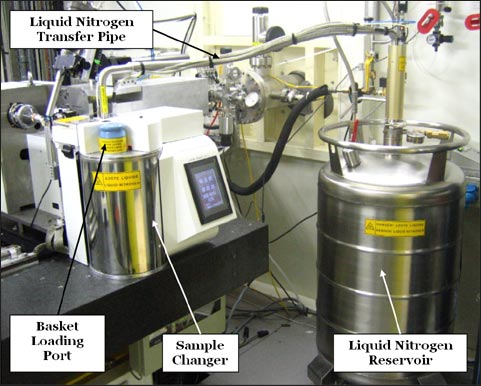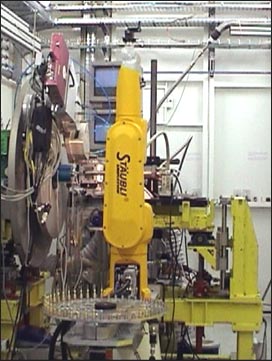- Home
- News
- Spotlight on Science
- Rapidly Changing...
Rapidly Changing Times at ESRF Beamlines
29-05-2006
Automation of ESRF experimental facilities has been the subject of intense activity over the last 5 years and a number of enhancements are now radically altering our perception of what is possible on X-ray beamlines at third generation synchrotron sources. Chief amongst these enhancements is the installation and successful commissioning of robotic sample changers. Sample changers of two different designs are now available on ID31 and on the Macromolecular Crystallography Group's beamlines.
Share
The sample changer for Macromolecular Crystallography, the SC3 (Figure 1), was developed through a collaboration between the ESRF, the EMBL-Grenoble and MRC-UK in consultation with the macromolecular crystallography community [1]. The SC3s operate at liquid nitrogen temperature and can hold up to 50 samples which are stored in five baskets and mounted in commercially available SPINE standard sample holders and thus are compatible with other commercially-developed sample changing systems. The SC3s have allowed external users to both screen the diffraction quality of more than 150 samples and to collect 80 full data sets per day. Work is underway to automate the entire process of diffraction quality screening, the ranking of samples of the same type and the subsequent collection of full data sets [2]. This process will revolutionise the routine use of ESRF Macromolecular Crystallography beamlines and is leading the way for future development of remote data collection capabilities.
 |
|
Fig. 1: SC3 robotic sample changer as installed on an ESRF Macromolecular Crystallography Group beamline (ID14-2). |
The robot on ID31 (Figure 2) was developed by a commercial company to ESRF specifications. It is simpler in design than the sample changers used for Macromolecular Crystallography as there is no need to store samples under liquid nitrogen. The robot accepts up to fifty samples on a carrousel, and is compatible with ID31's hot and cold gas blowers, allowing samples to be measured automatically in the temperature range from 80 K to ~1200 K. This allows a comprehensive exploration of phase diagrams, varying composition (different samples) and the effects of temperature.
 |
Fig. 2: The ID31 sample changer robot. |
References
[1] F. Cipriani, et al., & M. Renier, Submitted to J. Synch. Rad. (2006)
[2] A. Beteva, et al., & S. McSweeney, Submitted to J. Synch. Rad. (2006)
Authors
S. McSweeney, G. Leonard, A. Fitch
ESRF



